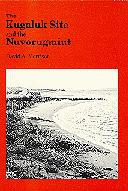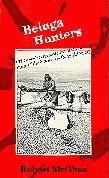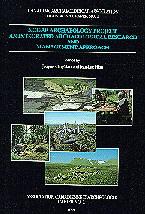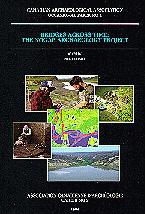
What Else Is Available
Books
 The
Kugaluk Site and the Nuvorugmuit.
The
Kugaluk Site and the Nuvorugmuit.
by David A. Morrison
This well-researched volume expands our understanding of the Nuvorugmiut seasonal exploitation of the caribou and the whale. This Western Arctic society, almost obliterated over the course of the last century, is brought to life in this vivid depiction. The author challenges the popular belief that all Inuit societies were egalitarian, suggesting that powerful whaling captains were the focus around which Nuvorugmiut life revolved.
 Iglulualumiut Prehistory: The Lost Inuit of Franklin Bay.
Iglulualumiut Prehistory: The Lost Inuit of Franklin Bay.
by David A. Morrison
This study examines material from four archaeological sites revealing the existence of a previously unrecognized late prehistoric/early historic Inuit society living in Franklin Bay, in the western Canadian Arctic. These people - the Iglulualumiut - had a culture closely resembling that of the neighbouring Mackenzie Inuit, of whom they can be considered an extension. They appear to have been of local Thule culture origin, and the last remnants of a once widespread Inuit occupation along the southern coast of Amundsen Gulf.
 Beluga Hunters
Beluga Huntersby Robert McGhee
One hundred years ago, some 2000 Inuit lived in the Mackenzie Delta and along the adjacent coasts of the Beaufort Sea. By the early twentieth century, most of these people had died of diseases contracted from Europeans and of starvation resulting from failed hunts. Their lands were settled by Inuvialuit immigrants from Alaska, and their traditional culture and way of life all but disappeared. This book reconstructs the culture and way of life of the Kittegaryumiut, located at Kittigazuit. The author interprets the archaeological evidence tracing the use of this beluga trap, and the occupation of Kittegazuit, five hundred years into the past.
 The
Crane Site and the Palaeoeskimo Period in the Western Canadian Arctic.
The
Crane Site and the Palaeoeskimo Period in the Western Canadian Arctic.
by Raymond J. Le Blanc
The Crane Site confirms that the Pre-Dorset period of Palaeoeskimo culture persisted on the western periphery of the Canadian Arctic long after the transition to Dorset had been completed elsewhere, for many of the artifacts are similar to those found at the Lagoon Site on Banks Island. This book explores the importance of the Crane Site and the assemblages found there in the context of the broader Palaeoeskimo world.
Ordering Information for the above CMCC books

 The
Canadian Archaeological Association's Occasional
Paper No.1 and No.2 present 25 articles dealing with various aspects
of the NOGAP Archaeology Project; management issues, training,
traditional knowledge, prehistory, methods and techniques. This
multi-year programme (1985-1994) was the result of the co-ordinated
efforts of the Yukon Heritage Branch, the Prince of Wales Northern
Heritage Centre and the Canadian Museum of Civilization.
The
Canadian Archaeological Association's Occasional
Paper No.1 and No.2 present 25 articles dealing with various aspects
of the NOGAP Archaeology Project; management issues, training,
traditional knowledge, prehistory, methods and techniques. This
multi-year programme (1985-1994) was the result of the co-ordinated
efforts of the Yukon Heritage Branch, the Prince of Wales Northern
Heritage Centre and the Canadian Museum of Civilization.Click here to see the table of contents of Occasional Paper No.1.
Click here to see the table of contents of Occasional Paper No.2.
Information on ordering the Occasional Papers of the Canadian Archaeological Association
Video Productions
(run time 49:40)
This documentary provides a general audience with an outline of the largest archaeological project ever undertaken by the federal government. Born from deep concerns with environmental questions, as expressed at the Berger inquiry of the mid-1970's, the Archaeological Project of the Northern Oil and Gas Action Plan (NOGAP) used a wide range of methods to learn about heritage resources in the lower Mackenzie Valley/Beaufort Sea region of Canada's Northwest Territories. Viewers are provided with examples of applied archaeological research which reach into the distant past in order to meet the needs of the future.
This video is also available in French, Gwich'in and Inuvialuktun.
 Click on the projector and view a scene from this documentary.
Click on the projector and view a scene from this documentary.Click here to read the transcript of this video.
The Riddle of Thunder River
(run time 7:21)
Historical and archaeological information combine with traditional knowledge to tell a fascinating tale about a place at the mouth of a small tributary stream of the Mackenzie River. This short video shows how understandings of the past can be gained from a wide variety of sources. Moreover, these bits of information complement each other and offer us a better appreciation for placenames in general.
This video is also available in French.
 Click on the projector and view a scene from this vignette.
Click on the projector and view a scene from this vignette.Click here to read the transcript of this video.
"That's Where They Gathered"; Tsiigehtchic
(run time 9:44)
The tiny Athapaskan settlement of Tsiigehtchic is located at the junction of the Arctic Red and Mackenzie Rivers. A familiar sight to travellers of the Dempster Highway is the small white church with its red roof, perched atop the steep cliff. Below Church Hill, on the Flats beside Ghost Lake, generations upon generations of Gwychia Gwich'in gathered to fish, to socialize and to exchange. Elders and archaeologists recount the history which lies beneath the tall grass of the Flats.
This video is also available in French.
 Click on the projector and view a scene from this vignette.
Click on the projector and view a scene from this vignette.Click here to read the transcript of this video.
Ancient Ways, New Visions; Traditional Knowledge
(run time 9:36)
Elders in native communities are guardians of centuries of knowledge passed on verbally from generation to generation. Knowledge about how their world works and how to live in it. In a way, Elders are like valuable books in a library with one exception; as they pass on, so does the accumulated wisdom of countless generations. By collecting traditional information with modern techniques of audio and video recording as well as writing, traditional knowledge crosses the generation gaps which have emerged in recent times, providing young people with a better sense of where they came from and where they might go.
This video is also available in French. Click on the projector and view a scene from this vignette.
Click on the projector and view a scene from this vignette.Click here to read the transcript of this video.
To order copies of these videos
